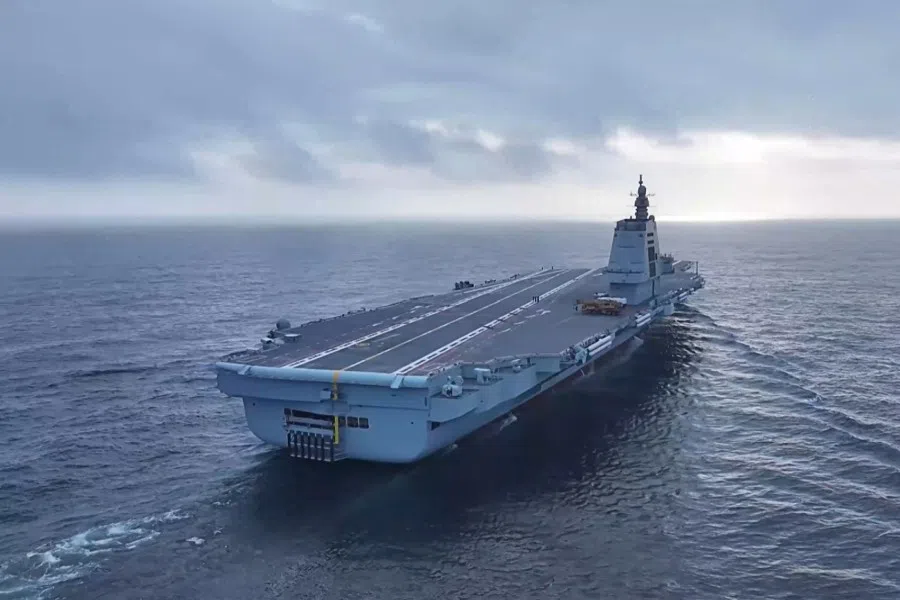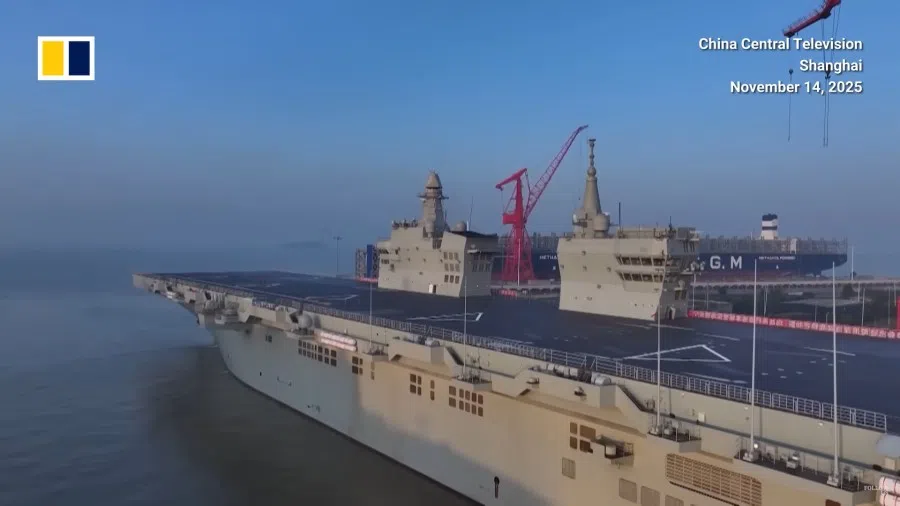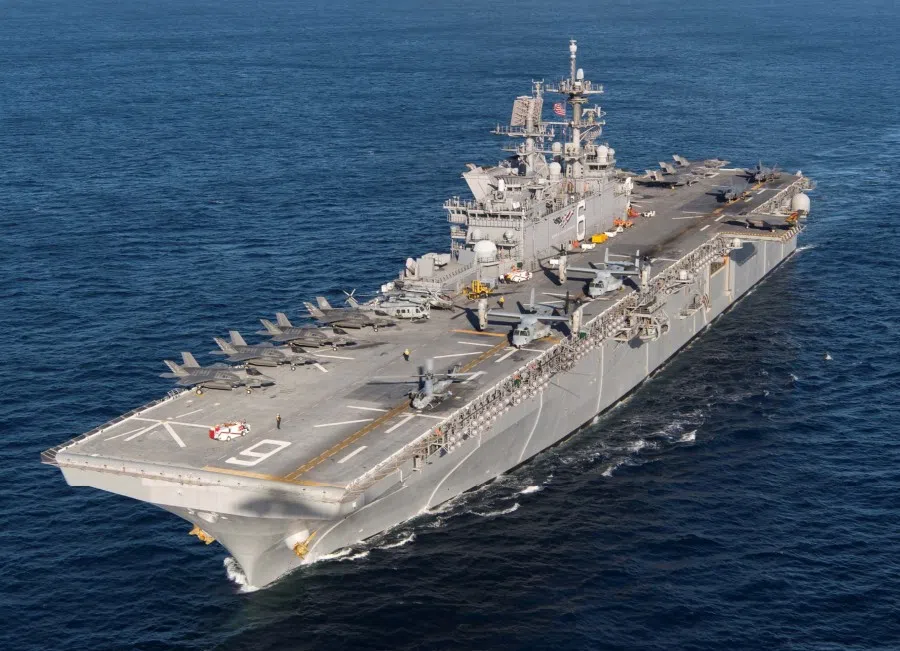Sichuan and Fujian: The two carriers that could reshape the Taiwan Strait
China’s new Type 076 Sichuan could reshape any Taiwan Strait conflict, pairing with the Fujian to form a potent two-carrier strike force as Beijing signals rising military confidence amid escalating East Asia tensions. Lianhe Zaobao’s China Desk explores the topic.

“Instead of focusing on the Fujian aircraft carrier, Taiwan should pay more attention to the Type 076 (the Sichuan).”
When retired Taiwanese major general Li Cheng-chieh made this remark on a political talk show on 14 November, he explained: “The Fujian won’t be deployed for operations against Taiwan. If anything happens in the Taiwan Strait, the Fujian is more likely to play a primary combat role in preventing US forces from intervening and carrying out anti-access/area-denial operations.”
Analysing the future combat role of China’s first new-generation Type 076 amphibious assault ship, the Sichuan, Li said: “The Sichuan’s missions will be multi-directional. It can intervene in small-scale regional conflicts, operate in coordination with the Fujian, or serve as the command ship for tri-service (land, sea, air) amphibious landing operations. It can operate both near and far.”
... the Sichuan and Fujian may form a paired “two-carrier strike combination” to respond to potential “East Asia contingencies”.
Sichuan-Fujian two-carrier strike combo
Nicknamed the “drone carrier”, the Sichuan completed its first three-day sea trial on 16 November and is expected to be formally commissioned by the end of 2026. Once operational, it will be capable of catapult-launching drones, the J-15T, the J-35 and other carrier-borne aircraft, making it the world’s first unmanned-aerial-vehicle carrier equipped with electromagnetic catapults.
Earlier, on 5 November, China’s third aircraft carrier — the Fujian, also the world’s first conventionally powered carrier using electromagnetic catapults — entered official service in Sanya, Hainan. The Sichuan’s commissioning one year later will mark the beginning of the People’s Liberation Army (PLA) Navy’s “dual electromagnetic-catapult platforms” era. The new ship has drawn wide discussion among Chinese military experts and enthusiasts over the past few days, with expectations that the Sichuan and Fujian may form a paired “two-carrier strike combination” to respond to potential “East Asia contingencies”.

The Type 076 is China’s largest amphibious assault ship to date and the first of its kind to be equipped with an electromagnetic catapult, capable of launching large drones for strike and reconnaissance missions. The first vessel was launched in Shanghai late last December, officially named Sichuan, with hull number 51 and a full-load displacement of over 40,000 tons.
After the Sichuan completed its first sea trial, China’s state news agency Xinhua reported that during the trial, a series of tests were conducted on the ship’s propulsion, power and other onboard systems, all of which achieved the expected results. Follow-up testing will proceed step by step in accordance with the overall construction schedule.
The Sichuan as a dual-island, drone-centric assault platform
In a special programme aired on 15 November, China Central Television’s Military Time (《军情时间到》) noted that compared with traditional amphibious assault ships, the most visually distinctive features of the Sichuan are its twin-island superstructure and full-length flight deck. The forward and aft islands have separate functions.
The forward island is responsible mainly for navigation command and can coordinate formation sailing with other ships, while the aft island handles aviation control, directing drones, helicopters and carrier-based aircraft from friendly vessels, greatly enhancing the efficiency of combat command.
... if war breaks out in the Taiwan Strait, the Type 076 — functioning as a drone carrier — could undertake missions such as theater surveillance, strike operations, combat support and airborne delivery... — Wang Shichun, Military Commentator, guancha.cn
The Sichuan’s full-length flight deck is noteworthy because it is the first time that electromagnetic catapult and arresting gear technology has been applied on an amphibious assault ship. This allows the vessel not only to carry a wide range of fixed-wing aircraft, helicopters, and large drones, but also to launch them using electromagnetic catapults, giving it combat capabilities approaching those of a light aircraft carrier.
Chinese military expert Du Wenlong analysed on the programme that the Sichuan’s displacement of over 40,000 tons signifies a major enhancement in its overall combat capability. A larger displacement and greater internal space allow it to carry more carrier-based aircraft, amphibious assault equipment and supplies, while also extending its endurance at sea. The ship can remain operational at sea for one to three months and, in an initial amphibious assault, may be able to disable or destroy the opponent’s frontline forces in one decisive strike.

Li Cheng-chieh assessed that one of the Sichuan’s dual islands can serve a joint-operations role, commanding landing forces. This includes directing carrier-based attack drones and helicopters to suppress enemy troops along the shoreline, and even commanding nearby warships to conduct naval gunfire strikes, destroying frontline defensive units and fortifications.
Wang Shichun, a military commentator for guancha.cn, believes that if war breaks out in the Taiwan Strait, the Type 076 — functioning as a drone carrier — could undertake missions such as theater surveillance, strike operations, combat support and airborne delivery, and, when necessary, carry out certain supporting landing tasks. In future scenarios where the PLA Navy needs to counter external intervention, the 076 would become a “versatile platform”, capable of handling nearly all missions from aerial fire support to troop transport.
Compared with aircraft carrier strike groups, amphibious assault ships require fewer support vessels for each deployment, lowering costs and enabling higher operational frequency.
Advantages of the Sichuan over the Fujian
What advantages does the Sichuan have over the Fujian? The military-affiliated WeChat account “First Military Intelligence” (第一军情) analysed on 14 November that compared with the Fujian — which is optimised for blue-water operations — the Sichuan can operate not only in distant seas but also effectively in the nearby waters of the East China Sea, Taiwan Strait and South China Sea. Its expected frequency of deployment and the diversity of missions it can undertake may exceed that of a conventional aircraft carrier, making it an important future pillar of the Chinese Navy.
Compared with aircraft carrier strike groups, amphibious assault ships require fewer support vessels for each deployment, lowering costs and enabling higher operational frequency. The US’s recent push for “lightning carriers”, which assign carrier-type missions to amphibious assault ships, reflects this same concept. The Sichuan’s electromagnetic-catapult system brings it closer to a traditional aircraft carrier, while still retaining the cost advantages of an amphibious assault ship.
On 14 November, Southern Metropolis Daily cited Chinese military expert Cao Weidong, who highlighted that the key difference between the Sichuan and the Fujian lies in whether a well deck is incorporated beneath the flight deck.
Cao explained that as an aircraft carrier, the Fujian has a continuous hangar deck beneath its flight deck, designed to house fixed-wing combat aircraft and early-warning aircraft. Its core missions include gaining air supremacy and sea control in deep-sea and oceanic theaters, as well as projecting power from sea to land — but it does not have the ability to transport amphibious assault equipment.
The Sichuan, as an amphibious assault ship, uses a dual-compartment design consisting of a hangar plus a well deck — the hangar stores helicopters, fixed-wing aircraft and drones, while the well deck is reserved for amphibious tanks, armoured vehicles and landing craft such as hovercraft. Its core mission is to conduct island-seizure and landing operations, enabling the delivery of troops and equipment from sea to shore.
The Sichuan, by contrast, retains a full well deck, allowing it to conduct ship-to-shore assaults using hovercraft and amphibious tanks, while simultaneously launching fixed-wing aircraft and drones through its electromagnetic catapult system.

Compared with the US Navy’s amphibious assault ship the USS America, Cao Weidong believes the Sichuan has greater functional advantages. He noted that the USS America removed its well deck to strengthen airstrike capability, which means it cannot deploy heavy amphibious equipment and must rely solely on aerial delivery to compensate. The Sichuan, by contrast, retains a full well deck, allowing it to conduct ship-to-shore assaults using hovercraft and amphibious tanks, while simultaneously launching fixed-wing aircraft and drones through its electromagnetic catapult system. This creates a multidimensional “airstrike + sea lift” integrated combat architecture.
With its 40,000-ton displacement, the Sichuan can carry fixed-wing aircraft and helicopters while still fully accommodating the loading requirements of amphibious equipment, achieving a balanced multi-role capability set.
Operational synergy between Sichuan and Fujian
How will the Sichuan coordinate with the Fujian after its commissioning? According to Du Wenlong, when a major operation arises or when China faces high military pressure, the PLA could embed amphibious ships within aircraft carrier strike groups. In large-scale landing missions, this would allow the task force to benefit from both the carrier’s protective umbrella and support from escort vessels, enabling high-intensity, long-range amphibious assaults.
“For low-intensity missions — for instance, when the target is small or the sailing distance is short — an independent formation can be built around the Type 076 Sichuan. Adding a Type 055 large destroyer, a Type 052D destroyer, frigates, submarines and supply ships would form an amphibious group capable of completing similar tasks. The force can scale up or down as needed, allowing flexible switching between full carrier and quasi-carrier configurations.”
Chinese military analyst Wei Dongxu believes that when required, the Fujian and Sichuan can form a joint maritime task force whose combined combat capability will be greater than the sum of its parts. In paired operations with the Fujian, the Sichuan can serve as a dedicated unmanned-aircraft carrier, launching a greater number of advanced drones that work with Fujian’s carrier-based fighters as loyal wingmen, forming an all-stealth collaborative combat system with the J-35 to conduct “door-breaking” missions, joint strikes, and suppressive fire.
Loyal wingmen are autonomous drone formations designed to carry out missions too difficult or dangerous for manned aircraft, enhancing reconnaissance and strike capabilities while protecting the lead aircraft.
Wei also noted that the Sichuan can deploy helicopters or large vertical-takeoff unmanned systems for logistics and ammunition resupply. “Together, the Sichuan and Fujian form the PLA Navy’s most powerful long-deck joint combat system. Certain carrier-based drones may even take off from one ship and land on the other, providing mutual redundancy during combat.”
... the Sichuan would take charge of landing and force projection onto Taiwan, while the Fujian would operate in waters east of Taiwan to sever escape routes for “Taiwan independence” forces and block interference from external powers. — “First Military Intelligence” (《第一军情》) analysis

The “First Military Intelligence” (《第一军情》) analysis further argues that beyond operating independently, the Sichuan can join a carrier strike group as an important supplement. If the Fujian undertakes a large-scale combat deployment, its primary aircraft would be manned platforms such as the J-35 and J-15T. Carrier-based fixed-wing drones on the Sichuan could then perform forward reconnaissance, data-link relay, loyal-wingman support, and even function as “arsenal aircraft” carrying munitions for manned fighters, substantially enhancing the strike group’s overall combat power.
If war breaks out in the Taiwan Strait, the Sichuan would work closely with the Fujian: the Sichuan would take charge of landing and force projection onto Taiwan, while the Fujian would operate in waters east of Taiwan to sever escape routes for “Taiwan independence” forces and block interference from external powers.
On 7 November, the same day China officially announced the commissioning of the Fujian, Japanese Prime Minister Sanae Takaichi made remarks about a “Taiwan contingency”, implying that Japan might intervene militarily in the Taiwan Strait. Her comments heightened already growing tensions in China-Japan relations. Against this backdrop, the Sichuan’s completion of its first sea trial on 16 November undoubtedly served as a strong military signal toward both Taiwan and Japan, demonstrating that in any potential conflict scenario, the PLA not only holds the initiative but also possesses multidimensional control over key maritime areas.
As Northeast Asia remains a significant geopolitical powder keg, whether the region will descend further into a spiralling arms race amid mutual anxieties is a question that observers and public opinion will continue to monitor closely in the short and medium term.
This article was first published in Lianhe Zaobao as “四川舰福建舰双舰合璧应对“东亚有事”?”.





